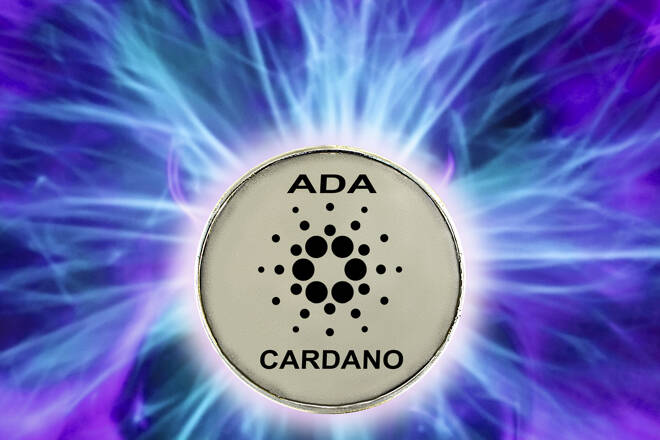Advertisement
Advertisement
ADA Price Prediction: Economic Jitters to Leave Sub-$0.300 in Play
By:
ADA found early support. However, barring a major Cardano network event, the NASDAQ Composite will likely influence through the afternoon session.
Key Insights:
- ADA joined the broader crypto in the red on Wednesday, falling by 2.52% to end the day at $0.310.
- Market risk aversion stemming from increased fears of a global economic recession weighed on riskier assets.
- The technical indicators are bearish, signaling a possible return to sub-$0.300.
On Wednesday, ADA fell by 2.52%. Following a 0.31% decline on Tuesday, ADA ended the day at $0.310. Notably, ADA fell to sub-$0.310 for the first time in seven sessions while extending its losing streak to three sessions.
A bullish start to the day saw ADA rise to an early morning high of $0.320. Coming up short of the First Major Resistance Level (R1) at $0.321, ADA fell to a late morning low of $0.307. ADA fell through the First Major Support Level (S1) at $0.314 and the Second Major Support Level (S2) at $0.311.
However, a bullish afternoon session saw ADA briefly break back through S2 before ending the day at $0.310.
Global Economic Recession Jitters Overshadow Network Updates
On Wednesday, risk aversion swept across the global financial markets as economic data from China raised more red flags. Trade data revealed sharp falls in imports and exports, signaling a weakening demand environment in Q4.
The bearish reaction to the news came despite reports of further reopening plans to boost economic activity. During the US session, investor sentiment failed to improve, with US bank executives raising the prospects of a US economic recession, adding to the doom and gloom.
While fears of an economic recession and uncertainty towards Fed monetary policy tested investor sentiment, Cardano network updates have been more upbeat.
This week, smart contracts on the Cardano network surpassed 4,300, reflecting the uptrend in developer activity despite the crypto market conditions.
According to Cardano Blockchain Insights, the total number of Plutus V1 Scripts stood at 4,313 on December 7, up from 3,920 on November 30, and 3,544 on October 31. Since September 22, the date of the Vasil hard fork, the number of Plutus V1 Scripts increased from 3,292, a 31% rise. The Alonzo hard fork added smart contract functionality in 2021.
On Tuesday, COTI announced the reactivation of its public Testnet version 1.1.1 of Djed, saying,
“We are happy to share that the public Testnet version 1.1.1 of Djed has been reactivated with new capabilities such as Vasil hard fork compatibility, activity history, and more.”
The announcement came as investors await the planned launch of two stablecoins on the Cardano network. In late November, COTI issued a press release saying that Djed, Cardano’s over-collateralized algorithmic stablecoin, will go live on the mainnet this January 2023. Emurgo’s stablecoin USDA is also set to go live in the New Year.
This morning, market conditions improved, though economic and Fed monetary policy uncertainty capped the upside early on. Barring a crypto event, the NASDAQ Composite Index will provide direction today. The NASDAQ mini was up 19 points to deliver early support.
ADA Price Action
This morning, ADA was up 0.32% to $0.311. A mixed morning saw ADA fall to an early low of $0.307 before rising to a high of $0.312.
Technical Indicators
ADA needs to move through the $0.312 pivot to target the First Major Resistance Level (R1) at $0.318 and the Wednesday high of $0.320. A return to $0.320 would signal a breakout session. However, ADA would need the broader market to support a bullish afternoon session.
In the event of an extended rally, the bulls will likely take a run at the Second Major Resistance Level (R2) at $0.325 and last week’s high of $0.326. The Third Major Resistance Level (R3) sits at $0.338.
Failure to move through the pivot would leave the First Major Support Level (S1) at $0.305 in play. However, barring a risk-off-fueled sell-off, ADA should avoid sub-$0.300 and the Second Major Support Level (S2) at $0.299. The Third Major Support Level (S3) sits at $0.286.
This morning, the EMAs and the 4-hourly candlestick chart (below) sent a bearish signal.
ADA sat below the 50-day EMA, currently at $0.316. The 50-day EMA fell back from the 100-day EMA, with the 100-day EMA pulling back from the 200-day EMA, delivering bearish signals.
An ADA breakout from the 50-day EMA ($0.316) would support a run at R1 ($0.318) and the 100-day EMA ($0.320). However, failure to move through the 50-day EMA ($0.316) would leave S1 ($0.305) in view.
About the Author
Bob Masonauthor
With over 28 years of experience in the financial industry, Bob has worked with various global rating agencies and multinational banks. Currently he is covering currencies, commodities, alternative asset classes and global equities, focusing mostly on European and Asian markets.
Did you find this article useful?
Latest news and analysis
Advertisement
